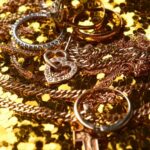Diamond cut is a crucial factor in the overall beauty and brilliance of diamond jewelry. In this introductory section, we will delve into the importance of diamond cut and provide an overview of diamond cut terminology. Understanding the significance of diamond cut will not only enhance your appreciation for these exquisite gemstones but also guide you in making informed decisions when purchasing or caring for diamond cut jewelry.
The history of diamond cut is a fascinating journey that spans centuries. From ancient techniques to modern innovations, this section will explore the origins and evolution of diamond cutting techniques. We will also highlight notable pioneers and innovators who have shaped the artistry of diamond cut jewelry throughout history.
As we dive deeper into understanding diamond cut, we will examine various styles and shapes that contribute to a diamond’s aesthetic appeal. Learn how different cuts impact a diamond’s brilliance and sparkle, and discover the unique characteristics of popular cuts such as round brilliant, princess, emerald, and marquise. By understanding these nuances, you can choose the perfect diamond cut that suits your personal style and preferences.
Join us on this captivating exploration of what makes diamond cut jewelry truly special. From exploring its rich history to unraveling the intricate anatomy of a well-cut diamond, this article offers insights and advice to help you appreciate and enjoy the unmatched brilliance of diamond cut jewelry.
History of Diamond Cut
The history of diamond cut is a fascinating journey that spans centuries and showcases the innovation and skill of jewelry artisans throughout time. Diamond cutting techniques have evolved tremendously, contributing to the mesmerizing brilliance and sparkle that diamonds are known for today.
Diamond cutting can be traced back to India in the 14th century, where artisans initially used rudimentary tools to shape rough diamonds into more desirable forms. The earliest known diamond cuts were simple table cuts, with facets located only on the top of the stone. As trade routes expanded and diamonds became highly sought after, different cultures began experimenting with different cutting styles.
One of the pivotal moments in diamond cut history happened during the Renaissance period in Europe when advancements in technology allowed for more intricate and precise diamond cuts. It was during this time that rose cuts gained popularity, featuring flat bases with faceted triangular or rectangular tops. The 17th century saw the birth of the first brilliant-cut diamonds, featuring multiple facets that enhanced their beauty even further.
In the 20th century, diamond cuts experienced a significant revolution with the introduction of machinery. The invention of advanced cutting techniques such as the round brilliant cut by Marcel Tolkowsky in 1919 revolutionized diamond cutting by maximizing light reflection and brilliance.
Throughout history, there have been pioneers and innovators who have left an indelible mark on diamond cut jewelry. From Gabriel Lemonnier’s introduction of the emerald cut in the 16th century to Asscher Brothers’ creation of the iconic Asscher cut in 1902, these individuals have made lasting contributions to shaping diamond cut styles as we know them today.
| Pioneers | Innovations | Year |
|---|---|---|
| Gabriel Lemonnier | Emerald Cut | 16th century |
| Asscher Brothers | Asscher Cut | 1902 |
| Marcel Tolkowsky | Round Brilliant Cut | 1919 |
Understanding Diamond Cut
Diamond cut plays a crucial role in the overall aesthetics and impact of a diamond. The way a diamond is cut determines its ability to reflect and refract light, which directly influences its brilliance and sparkle. Understanding different diamond cut styles and shapes can help individuals in selecting the perfect diamond for their jewelry.
Different Diamond Cut Styles and Shapes
There are various diamond cut styles and shapes available in the market, each with its own unique characteristics. The most popular and well-known cut is the round brilliant cut, which features 58 facets that maximize the diamond’s reflective properties. This cut offers exceptional sparkle and is often considered a classic choice for engagement rings.
Other popular diamond cuts include the princess cut, which is square or rectangular with pointed corners, giving it both modern elegance and versatility. The emerald cut showcases long, rectangular facets that create a hall-of-mirrors effect, emphasizing the diamond’s clarity rather than its sparkle. The marquise cut, on the other hand, has an elongated shape with curved sides that elongates fingers when set in jewelry.
Impact of Diamond Cut on Brilliance
The brilliance of a diamond refers to its ability to reflect white light back to the viewer’s eye. It is determined by how well the angles of the facets are aligned to reflect light internally within the stone. When a diamond is cut too shallow or too deep, light leaks out from the bottom or sides instead of being reflected back through the top, resulting in reduced brilliance.
A perfectly-cut diamond allows light to enter through its table (the flat top surface), bounce off its internal facets multiple times, then exit through either the table or crown (the top part of the diamond). This optimizes its ability to disperse light into various colors and create flashes of brilliance known as scintillation.
Comparison of Popular Diamond Cuts
Each diamond cut has its own visual characteristics and personality. For example, round brilliant cuts have a classic and timeless appearance with maximum fire and brilliance. Princess cuts offer a more contemporary and modern look. Emerald cuts showcase a unique combination of elegance and sophistication, while marquise cuts provide an elongated and dramatic shape.
When comparing diamond cuts, it is important to consider personal preferences, as well as the occasion or jewelry design for which the diamond will be used. Some individuals may prioritize sparkle and brilliance, while others may gravitate towards a particular shape or style that suits their taste.
Understanding the impact of diamond cut on the overall aesthetics of a diamond can help buyers make informed decisions when selecting their diamond jewelry. By choosing the right cut, individuals can ensure that their diamonds exude beauty, brilliance, and reflect their personal style.
Factors Affecting Diamond Cut Quality
Importance of Diamond Cut in Determining Quality
When it comes to the quality of a diamond, the cut is often considered the most critical factor. The diamond’s cut refers to how well its facets interact with light, ultimately determining its brilliance, fire, and sparkle. A well-cut diamond can maximize the stone’s optical performance, while a poorly cut diamond may appear dull and lifeless.
The 4Cs and the Significance of Cut
Cut is one of the four Cs used to evaluate a diamond’s quality, alongside carat weight, clarity, and color. While each of these factors contributes to a diamond’s overall value, experts generally agree that cut has the most significant impact on its appearance. In fact, even if a diamond has high color and clarity grades, it will not exhibit optimal light performance without an excellent cut.
The cut grade evaluates three main components: proportions (the relationships between different parts of the stone), symmetry (the alignment and arrangement of facets), and polish (the smoothness and condition of the surface). The Gemological Institute of America (GIA) developed a universal grading system for diamond cuts ranging from Excellent to Poor. Other reputable organizations have also established their own grading scales.
Diamond Cut Grading Systems and Benchmarks
The GIA’s cut grading scale ranges from Excellent to Poor. Diamonds with an Excellent or Very Good rating are considered top-tier in terms of light performance and visual appeal. Good-rated diamonds still offer decent brilliance but may not exhibit as much fire or sparkle as higher-grade stones. Fair-graded diamonds tend to lack overall brightness and scintillation, while Poor-graded diamonds often appear noticeably dull.
Apart from the GIA grading system, other organizations have their own standards for evaluating diamond cuts. For instance, the American Gem Society (AGS) uses a 0-10 grading scale, with 0 representing the highest quality. Each grading system places importance on specific aspects of diamond cut, such as table size, depth percentage, and crown and pavilion angles.
Understanding the various grading systems and benchmarks can be helpful when evaluating diamond cut quality. Whether you are purchasing a diamond for an engagement ring or simply appreciating the beauty of a well-cut stone, understanding the significance of cut in determining a diamond’s appearance is crucial. By considering all factors affecting diamond cut quality, you can ensure that your jewelry piece shines with unmatched brilliance.
The Anatomy of a Diamond Cut
When it comes to diamond cut jewelry, understanding the anatomy of a diamond cut is essential in appreciating its brilliance and beauty. The cut of a diamond refers not only to its shape but also to the proportions, symmetry, and arrangement of its facets. These factors work together to maximize the reflection and refraction of light within the stone, resulting in the mesmerizing sparkle that diamonds are known for.
A diamond’s cut consists of various facets that are carefully crafted to interact with light in specific ways. Each facet plays a role in how light enters the diamond, reflects internally, and exits back through the top surface. The most important component of a diamond’s cut is its table, which is the flat top facet that allows light to enter and exit the stone.
On either side of the table are a series of triangular or kite-shaped facets called mains or bezels. These facets help direct light towards the center of the diamond.
Another crucial aspect of a diamond’s cut is its pavilion, which is located below the table facet. The pavilion consists of lower girdle facets and culet – the pointed tip at the base – which redirect light back through the top surface of the diamond. The angles and proportions of these lower facings determine how efficiently light is reflected within the stone.
Symmetry also plays a vital role in achieving an exceptional diamond cut. It refers to how well-aligned each facet is with one another as well as with other elements of the stone. Symmetrical placement ensures that every facet works harmoniously to maximize brilliance while avoiding any imbalance or misalignment that could result in reduced sparkle.
Precision is another crucial factor in creating an exceptional diamond cut. Every angle, facet, and measurement must be meticulously calculated and executed for optimal visual performance. Even slight deviations from ideal proportions can significantly impact how effectively light interacts with the stone.
Popular Diamond Cut Styles in Jewelry
When it comes to diamond cut jewelry, there are several popular styles that have captured the hearts of jewelry lovers worldwide. Each diamond cut style possesses its own unique beauty and characteristics, making them suitable for various preferences and occasions.
- Round Brilliant Cut: The round brilliant cut is one of the most popular and classic diamond cuts. It features a symmetrical shape with 58 facets that maximize the diamond’s brilliance and sparkle. This cut is known for its timeless appeal and versatility, making it perfect for any type of jewelry, from engagement rings to necklaces.
- Princess Cut: The princess cut is a square or rectangular-shaped diamond cut that exhibits exceptional fire and brilliance. With its clean lines and modern look, it has become a sought-after choice for engagement rings and statement earrings. The princess cut can be set in various styles, including solitaire settings or surrounded by smaller diamonds in a halo design.
- Emerald Cut: The emerald cut is characterized by its rectangular shape with step-cut facets on the four corners. This cut emphasizes clarity rather than brilliance, showcasing the diamond’s impeccable transparency and unique depth of color. Emerald-cut diamonds are often used in engagement rings or as center stones in three-stone designs.
- Marquise Cut: The marquise cut is known for its distinctive elongated shape with pointed ends, resembling a football or boat shape. This cut creates an illusion of length and makes fingers appear longer when set in rings. Marquise-cut diamonds are often used as center stones in engagement rings or featured prominently in pendants.
Each diamond cut style offers its own allure and charm, ensuring that there is something to suit every individual taste and style preference.
| Diamond Cut Style | Characteristics |
|---|---|
| Round Brilliant | Classic, versatile, maximum brilliance and sparkle |
| Princess Cut | Square or rectangular shape, modern look, exceptional fire and brilliance |
| Emerald Cut | Rectangular shape, step-cut facets, emphasis on clarity and transparency |
| Marquise Cut | Elongated shape with pointed ends, creates an illusion of length |
Whether you prefer the timeless elegance of a round brilliant cut or the modern sophistication of a princess cut, choosing a diamond cut style that resonates with you is essential when purchasing diamond cut jewelry. Each style has its own unique features and characteristics that can enhance the overall beauty of the piece. Consider your personal taste, lifestyle, and the type of jewelry you are looking to purchase when selecting a diamond cut style.
It is also worth noting that different diamond cuts can be complemented by specific settings. For example, round brilliant cut diamonds are often set in prong or halo settings to showcase their brilliance from all angles.
Princess cut diamonds tend to be set in a traditional four-prong setting or surrounded by smaller diamonds in a channel setting. Understanding how different diamond cuts can be enhanced by various settings can help you make informed choices when creating or selecting your dream jewelry piece.
Diamond Cut Jewelry
When it comes to buying diamond cut jewelry, there are a few important tips to keep in mind to ensure that you make the right choice. Here are some guidelines to help you select the perfect diamond cut for your preferences and jewelry designs.
- Consider Your Personal Style: One of the first things to consider when buying diamond cut jewelry is your personal style. Different diamond cuts have different aesthetics and qualities that can complement various styles. For example, if you prefer a classic and timeless look, a round brilliant cut may be the perfect choice. On the other hand, if you prefer something more modern and unique, an emerald or marquise cut might be ideal.
- Budget: Another crucial factor to consider is your budget. Diamond cut can greatly affect the price of a diamond, so it’s important to determine how much you’re willing to spend beforehand. Round brilliant cuts are typically priced higher due to their popularity and demand, while less common cuts like princess or marquise can provide excellent value for money.
- Quality Assessment: When purchasing diamond cut jewelry, it’s essential to assess its quality beyond just the 4Cs (carat, clarity, color, and cut). Pay attention to factors such as symmetry, polish, and proportions, as these greatly impact a diamond’s beauty and brilliance. Look for diamonds with excellent symmetry and precision in their facets for optimal light reflection and sparkle.
Caring for your diamond cut jewelry is equally important in ensuring its longevity and maintaining its stunning appearance over time. Here are some tips on how to care for your precious pieces:
- Regular Cleaning: To keep your diamond cut jewelry looking its best, regular cleaning is essential. You can clean most diamond cuts with warm water and mild soap using a soft brush or cloth gently. Be sure to rinse thoroughly and pat dry with a lint-free cloth afterward.
- Safe Storage: When you’re not wearing your diamond cut jewelry, it’s important to store it properly to prevent scratches or damage. Consider using a soft pouch or individual compartments in a jewelry box to keep each piece separate and protected.
- Professional Maintenance: While regular cleaning can help maintain the integrity of your diamond cut jewelry, it’s also recommended to have your pieces professionally inspected and maintained periodically. A professional jeweler can check for loose stones, prongs, or any other issues that may need attention.
By keeping these tips in mind when buying and caring for diamond cut jewelry, you’ll be able to select the perfect piece that matches both your style and budget while ensuring its longevity and beauty for years to come.
Diamond Cut Jewelry
Investing in diamond cut jewelry can be a wise financial decision, as the diamond cut plays a crucial role in determining its value and market price. When it comes to diamonds, the cut refers to how well a diamond has been shaped and faceted, influencing its brilliance, sparkle, and overall beauty.
The better the cut quality of a diamond, the more valuable it becomes. Understanding the investment potential of diamond cut jewelry is essential for both seasoned collectors and first-time buyers.
The market price of diamond cut jewelry heavily relies on the quality of its cutting. A well-cut diamond reflects light perfectly, creating an exceptional display of brilliance and fire. This makes it highly sought after by consumers, which increases its demand and subsequently drives up its value. On the other hand, poorly cut diamonds with inadequate proportions may exhibit reduced brilliance and lackluster performance, resulting in decreased value.
In addition to its impact on market price, the diamond cut also affects the resale value of jewelry pieces. Well-cut diamonds tend to hold their value better over time compared to diamonds with inferior cuts.
The precision of the facets and angles directly influences how light interacts with each facet, enhancing or diminishing its beauty. Therefore, when investing in diamond cut jewelry for potential resale purposes, it is imperative to consider factors such as excellent craftsmanship and high-quality cutting.
When contemplating an investment in diamond cut jewelry, it is important to keep track of current market trends and demands. Different styles of cuts experience fluctuations in popularity over time due to evolving fashion trends or cultural preferences.
For instance, round brilliant cuts have consistently remained popular throughout history due to their timeless appeal and exceptional brilliance. On the other hand, fancy shapes like princess cuts or emerald cuts may experience varying levels of demand depending on different factors such as celebrity endorsements or emerging design trends.
Investing in premium quality diamond cut jewelry not only ensures you possess a stunning piece but also provides potential for financial growth. The exceptional beauty and allure of well-cut diamonds have mesmerized individuals for centuries, making them highly coveted commodities. Whether you are purchasing diamond cut jewelry as a personal adornment or as an investment, understanding the value and significance of the diamond cut is crucial in making an informed decision.
Please consult with a professional jeweler or gemologist for personalized advice and guidance when investing in diamond cut jewelry. They can offer expert opinions on current market trends, assist in selecting high-quality cuts, and provide maintenance tips to ensure the longevity of your precious pieces. Diamond cut jewelry represents an investment that combines timelessness and beauty-one that can be treasured for years to come.
Conclusion
In conclusion, diamond cut jewelry is undeniably a key element in the overall beauty and brilliance of a diamond. Its importance cannot be overstated, as the cut determines how effectively light is reflected and refracted within the stone, ultimately resulting in its sparkle and fire. Through exploring the history, understanding the different styles and shapes, and appreciating the factors that affect diamond cut quality, one can truly appreciate the artistry and craftsmanship behind these exquisite pieces.
Throughout centuries, diamond cutting techniques have evolved significantly, thanks to pioneers and innovators who have paved the way for this delicate craft. From the traditional round brilliant cut to more contemporary cuts like princess, emerald, and marquise, each style brings its own unique attributes that cater to different tastes and preferences. It is fascinating to see how various combinations of facets, proportions, symmetry, and precision can create such breathtaking visual performances.
When purchasing diamond cut jewelry, it is essential to consider personal style preferences and budget. Choosing the right cut can make all the difference in a piece’s overall aesthetic appeal. Additionally, proper maintenance and cleaning are crucial to preserve its value over time. By taking care of your diamond cut jewelry diligently, you ensure its longevity for future generations to enjoy.
Frequently Asked Questions
Does diamond cut mean real diamonds?
Diamond cut does not necessarily mean real diamonds. In the context of jewelry, diamond cut refers to the specific way in which a diamond is shaped and faceted, enhancing its brilliance and sparkle.
This term can also be used for other gemstones or even materials that mimic the appearance of diamonds, like cubic zirconia. So, while diamond cut may indicate the quality of a real diamond’s craftsmanship, it can also describe the cutting technique applied to other materials.
What is the difference between diamond cut chain and normal?
The main difference between a diamond-cut chain and a normal chain lies in their appearance. A diamond-cut chain features intricate facets that create reflective surfaces which resemble those of diamonds. These facets help to catch and reflect light, giving the chain added brilliance and sparkle.
On the other hand, a normal chain typically has a smooth surface without any special texturing or enhanced reflective properties. So, while both chains serve their primary function as necklace or bracelet adornments, the diamond-cut chain offers an extra touch of visual allure.
Is diamond cut chain good?
Generally speaking, a diamond-cut chain can be considered good if you appreciate its unique aesthetic appeal. The faceted surfaces created through the cutting process enhance the shine and lustre of the metal, adding a touch of elegance to your overall look when worn as jewelry. However, personal preference plays an important role here since not everyone might be fond of such embellishments on their chains.
Additionally, it’s worth noting that the durability and quality of any chain depend on factors beyond just its cutting style – factors like material (gold, silver, etc. ), thickness or gauge, clasp type, etc., all contribute to determining whether a specific diamond-cut chain is good or not in terms of longevity and reliability.

Welcome to my jewelry blog! My name is Sarah and I am the owner of this blog.
I love making jewelry and sharing my creations with others.
So whether you’re someone who loves wearing jewelry yourself or simply enjoys learning about it, be sure to check out my blog for insightful posts on everything related to this exciting topic!





